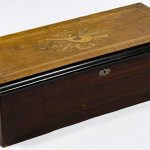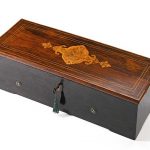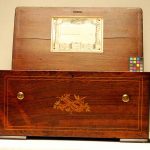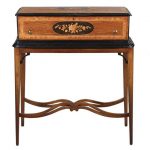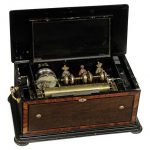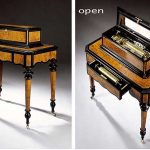Marquetry. Techniques of wood marquetry were developed in Antwerp and other Flemish centers of luxury cabinet-making during the early 16th century. The craft was imported full-blown to France after the mid-seventeenth century, to create furniture of unprecedented luxury being made at the royal manufactory of the Gobelins, charged with providing furnishings to decorate Versailles and the other royal residences of Louis XIV. Early masters of French marquetry were the Fleming Pierre Golle and his son-in-law, André-Charles Boulle, who founded a dynasty of royal and Parisian cabinet-makers (ébénistes) and gave his name to a technique of marquetry employing tortoiseshell and brass with pewter in arabesque or intricately foliate designs. Boulle marquetry dropped out of favor in the 1720s, but was revived in the 1780s. In the decades between, carefully matched quarter-sawn veneers sawn from the same piece of timber were arranged symmetrically on case pieces and contrasted with gilt-bronze mounts. Floral marquetry came into favor in Parisian furniture in the 1750s, employed by cabinet-makers like Bernard van Risenbergh, Jean-Pierre Latz and Simon-François Oeben. The most famous royal French furniture veneered with marquetry are the pieces delivered by Jean Henri Riesener in the 1770s and 1780s. The Bureau du Roi was the most famous amongst these famous masterpieces. Reference: Wikipedia
Some of the best musical movements are encased in marquetry boxes.
Swiss Marquetry Case Music Box Swiss music box with wood case having marquetry on lid, an eight inch brass cylinder which plays 10 airs listed on the decorated label on the underside of the lid; marked ‘Switzerland’ on the underside of case
Sold for $160 at Leonard Auction, Inc. in 2019
Nicole Frères A FINE AND RARE SMALL KEYWIND ROSEWOOD AND FRUITWOOD MARQUETRY PIANO FORTE MUSIC BOX WITH FOUR OPERATIC TUNES NO 32446 CIRCA 1850 • rosewood and rosewood grained rectangular box with fruitwood marquetry, flat lid with inlaid floral motif, door to the side to revealing the winding aperture and operating levers, the lid with tune sheet, opening to the right for key storage • the movement with steel comb, brass cylinder, and instant stop height 5 in (12.5 cm), width 16 in (41 cm), depth 6 in (15 cm)
The present piece is both an early example as well as a very rare ‘miniature’ piano forte box, both highly sought out features in piano forte boxes. Furthermore it survives in excellent condition, including the sound of the piano forte comb and all four tunes, which resonate with crisp and perfect tune. The original tune sheet includes two songs by Verdi, one by Bellini, and the last by Julliere. The dampers to the bottom of the comb remain in excellent condition and contribute to the sound made by such a small example.
Sold for 6,000 USD at Sotheby’s in 2014
Cylinder musical box in a rosewood case with marquetry decoration, playing 6 airs with bell movement. No key. Tune sheet marked ‘Fabrique de Geneve’.
Reference: © Victoria and Albert Museum
A Swiss bells and drum in view cylinder music box on stand In a marquetry, the interior with reverse painted glass panel with coat of arms ABOVE BY her MAJESTY’S ROYAL LETTER PATENT dimensions of box 9 1/2in x 26 1/2in x 12in (24.3cm x 68cm x 30.3cm); overall height 21 1/2in (54.5cm)
Sold for US$ 1,275 (£ 1,015) inc. premium at Bonhams in 2019
A SWISS WALNUT-CASED AND ROSEWOOD AND FRUITWOOD INLAID ‘STELLA DISC’ MUSICAL BOX RETAILED BY J.F.MÜLLER, THE PATENT DATED 1885, PROBABLY EARLY 20TH CENTURY The top and interior of lid inlaid with floral marquetry; together with seventeen various ‘Stella discs’ The box: 10 ½ in. (26.5 cm.) high; 28 ½ in. (72.5 cm.) wide; 21 ½ in. (54.5 cm.) deep
Sold for GBP 875 at Christie’s in 2018
Marquetry Inlaid Walnut and Parcel Ebonized Music Cylinder Box on Stand Franz Koch Hof-Uhrmacher, Berlin The rectangular box with a hinged lid decorated on the front and top with a central floral reserve, opening to reveal a single cylinder which plays twelve airs, the parcel black painted mahogany stand with a stepped rectangular top, raised on tapering legs joined by an arched X-form stretcher. Height of music box 6 1/4 inches, width 28 inches, depth 10 1/4 inches, height of stand 26 1/2 inches, width 30 inches.
Sold for $3,437 (includes buyer’s premium) at Doyle New York in 2011
